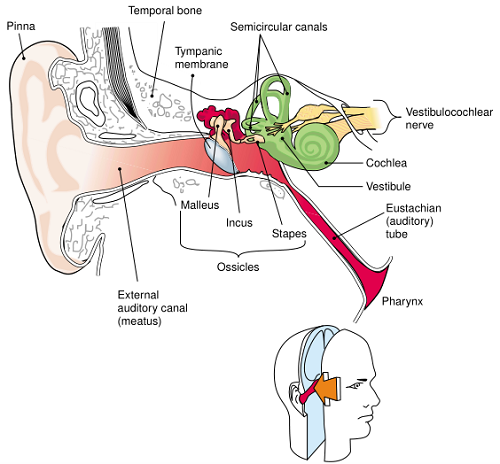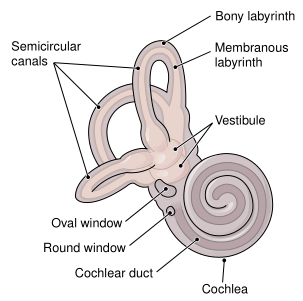The ear has the receptors for both hearing and equilibrium. For study purposes, it may be divided into three parts: the outer, middle, and inner ear (Fig. 18-1). The outer ear consists of the projecting pinna (auricle) and the external auditory canal (meatus). This canal ends at the tympanic membrane or eardrum, which transmits sound waves to the middle ear. Glands in the external canal produce a waxy material, cerumen, which protects the ear and helps to prevent infection.
Spanning the middle ear cavity are three ossicles (small bones), each named for its shape: the malleus (hammer), incus (anvil), and stapes (stirrup). Sound waves traveling over the ossicles are transmitted from the footplate of the stapes to the inner ear. The eustachian tube connects the middle ear with the nasopharynx and serves to equalize pressure between the outer and middle ear.

FIGURE 1. The ear, showing the outer, middle, and inner subdivisions. (Reprinted with permission from Cohen BJ, Wood DL. Memmler's The Human Body in Health and Disease. 9th Ed. Philadelphia: Lippincott Williams & Wilkins, 2000.)
The inner ear, because of its complex shape, is described as a labyrinth (Fig. 2). It consists of an outer bony framework containing a similarly shaped membranous channel. The entire labyrinth is filled with fluid.

FIGURE 2. The inner ear. (Reprinted with permission from Smeltzer SC, Bare BG. Brunner & Suddarth's Text-book of Medical-Surgical Nursing. 9th Ed. Philadelphia: Lippincott Williams & Wilkins, 2000.)
The cochlea, shaped like the shell of a snail, has the specialized organ of Corti concerned with hearing. Cells in this receptor organ respond to sound waves traveling through the fluid-filled ducts of the cochlea. Sound waves enter the cochlea from the base of the stapes through an opening called the oval window and leave through another opening called the round window.
The sense of equilibrium is localized in the vestibular apparatus. This structure consists of the chamber-like vestibule and three projecting semicircular canals. Special cells within the vestibular apparatus respond to movement. (The senses of vision and proprioception are also important in maintaining balance.)
Nerve impulses are transmitted from the ear to the brain by way of the vestibulocochlear nerve, the eighth cranial nerve, also called the acoustic or auditory nerve. The cochlear branch of this nerve transmits impulses for hearing from the cochlea; the vestibular branch transmits impulses concerned with equilibrium from the vestibular apparatus.
责任编辑:admin
上一篇:中医文章阅读——Spleen
下一篇:中医文章阅读——Lungs

微信公众号搜索“译员”关注我们,每天为您推送翻译理论和技巧,外语学习及翻译招聘信息。